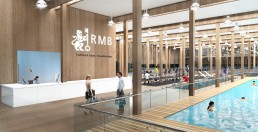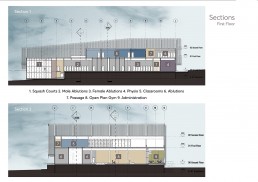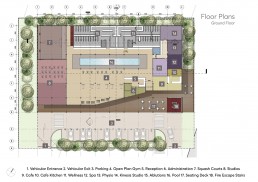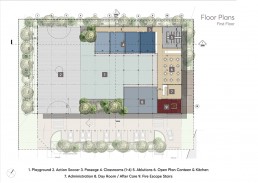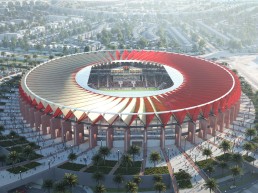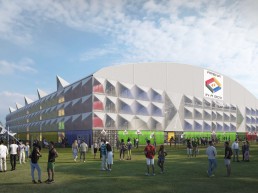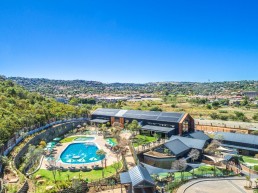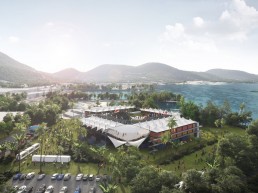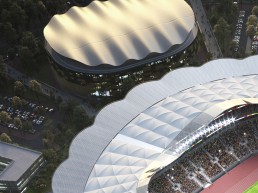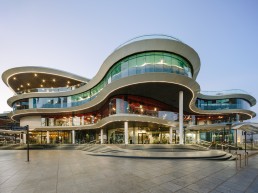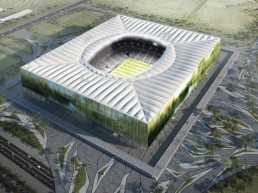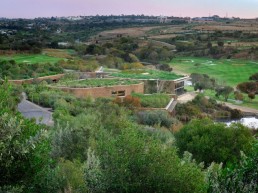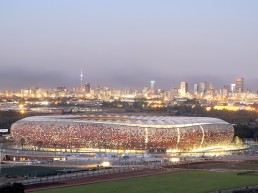This proposal was put together for an open site in the Sandton CBD, some of the most expensive real estate in South Africa. The client asked Boogertman+Partners(B+P) to look at the erection of a small multi-purpose building that would pull non-core functions out of the buildings on the two campuses surrounding the site to allow maximum efficiency in the use of these, while at the same time offering added value propositions to their employees. From the outset, it was clear that this new structure would never be the final solution on this particular piece of land. The property was too valuable and too well place to be so underdeveloped, however, there was an immediate need for the facility.
Timber construction, with its extensive off-site pre-manufacture, carbon neutrality and ease of modular assembly was the right to approach to solving this particular problem.
In response, B+P conceptualised a building that could be assembled as quickly as possible on-site and put to use, but then as easily and efficiently be dissembled (and possibly re-used) when the time came to develop the site to it’s full potential. The typical construction approach of concrete, brick and mortar were not a suitable solution in terms of both time for erection as well as ease of disassembly.
Timber construction, particularly Cross Laminated Timber(CLT), is not widely used in South Africa yet, and this project gave us the chance to work with and understand the technology, it’s benefits and it’s opportunities. Partnering with a global timber construction authority, Arup consulting engineers, we put together a scheme that met the client’s brief in terms of functionality, adaptability and efficiency while not incurring unsustainable abortive costs. Timber construction is among the oldest of architectural technologies. Used for centuries across the world it is a proven renewable and reliable resource.
In the mid-1990’s the Austrian government launched a joint industry-academic study to develop a stronger, “engineered” wood to soak up its oversupply of timber. The result of this is cross-laminate-timber (CLT). CLT’s beauty lies in its resolution of a tricky timber conundrum. Timber is only strong in one direction, along its grain. Structural forces applied against its grain cause it to fail. Cross laminate timber stitches together layers of wood with the grain’s perpendicular to one another, ensuring structural stability in all directions. It allows for the recycling of wood waste on the make-up of the panels. CLT timber is supplied in various formats, creating a “kit of parts” that allows the building to be engineered almost like a piece of furniture, with almost all elements manufactured off-site and then assembled once on site.
This “kit of parts” approach allows for the building to be completely and economically disassembled in the future and then reassembled elsewhere, either as the same building in its entirety or as a new piece of architecture erected from the same parts. It also allows for the building as a whole to be donated to a suitable cause or organisation and then re-assembled in the position where it is most useful to them. Engineered timber construction is not only carbon neutral, it’s carbon negative. Multi-storey timber buildings under construction in cities like London, Vancouver and others will only become carbon neutral AFTER around 20 years of life (this is dependent on other factors also), as the services and emissions of the occupants tally up. Properly managed and stewarded commercial forests are a carbon SINK, extracting CO2 from the atmosphere. They are also endlessly renewable.
The building
To assist with the assemble/disassemble principle, the building is arranged on a strict modular grid, meaning elements are made to standard sizes to allow for ease of re-use and re-assembly.
In terms of function, the gym is located on the ground floor, with the creche and it’s playground covering the gym’s “roof”. This is done both for the practical reasons; the activities and equipment in the gym have weight and noise implications, there are substantial services for HVAC and plumbing that need to be considered. As well as for security concerns; the creche being on the upper level means that it has a double layer of surveillance, both at the ground level access and at the creche reception, children are not able to wander out of the creche environment unless supervised.
Spatially, the gym is arranged around the central swimming pool. Areas requiring offices, such as nutritionists, physios, biokinetics, are organised adjacent to the entrance to allow for ease of access away from the noisy studio and weight areas. The change rooms are located along the back edge of the building, close to the pool so that people in swimming costumes who may be self-conscious can quickly get into the pool without walking across other areas. The squash courts are positioned in the far corner and sunk into the ground to accommodate their height requirements. Free weights and studios are located across the main street façade to get maximum light and connection to the outside.
At the entrance to the gym is a coffee shop/small restaurant which will be the common interface between employees visiting the gym and parents dropping off or waiting to pick up their children. It provides a focal point from which all areas of the building are accessed.
The creche is organised around partially covered play court, with all rooms opening to the south to provide soft light into the building. The reception/admin area encloses the entrance, with the aftercare room immediately adjacent to ensure there is always surveillance of the front door which is the only exit. Canteen kitchen and ablutions are positioned close together for efficiency in wet services reticulation. The creche is purposefully over the office area of the gym to reduce the possibility of noise from the aerobics and spinning studios disturbing the children.
In addition to the gym and creche, two multi-use courts are also provided, one on the creche level and one above the creche. These are for sports such as five-a-side soccer and basketball, as well as for general RMB events which would otherwise need to be hosted in a rented venue. The courts have completely separate access around both the gym and creche meaning that they can be used independently of these.
HVAC plant is located above the creche adjacent to the multiuse court In terms of sustainable strategies, all grey water from showers and irrigation will be captured, processed and re-used for toilet flushing and irrigation, as well as all stormwater captured on the building and the site.
| Proposal | 2019 |
| Developer | ERIS Property group |
| Consulting Engineers | ARUP |
